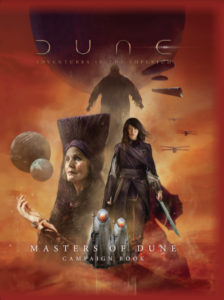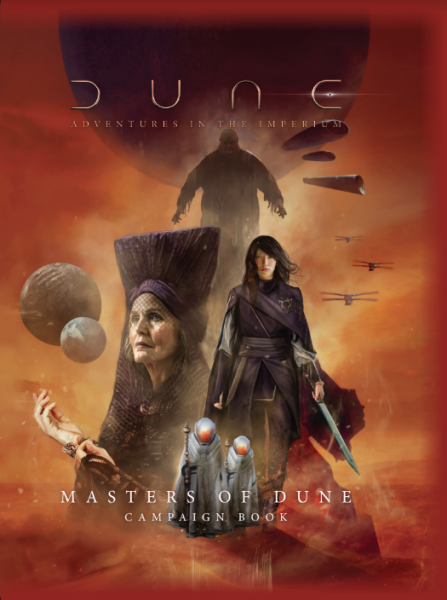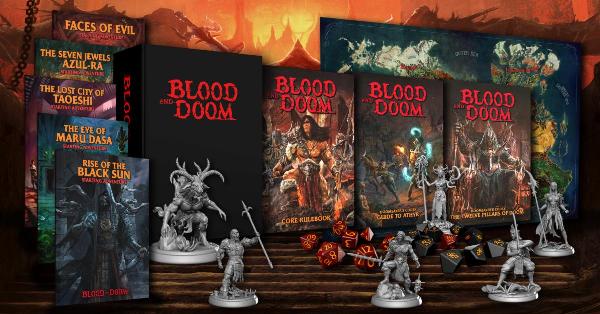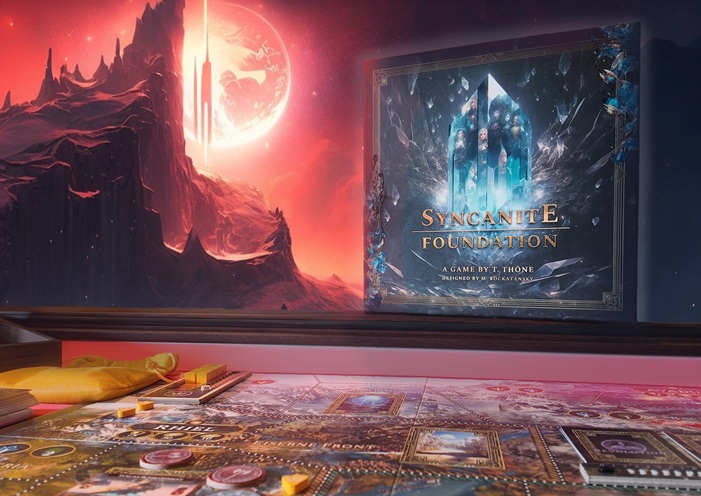
Masters of Dune
Masters of Dune is a science fiction campaign for Dune: Adventures in the Imperium, written by Andrew Peregrine, Simon Berman, Jonathan Breese, Jason Durall, Keith Garrett, Hilary Sklar, Devinder Thiara, Jared Twing, and Rachel J. Wilkinson and published by Modiphius Entertainment.
By Aaron T. Huss

Learn more about Masters of Dune here
Purchase Masters of Dune here (paid link)
Find other Dune posts here
Masters of Dune is a campaign that picks up where the introductory Agents of Dune left off and pits the players within the storyline of the original Dune novel. However, it takes a micro and macro look at the storyline by allowing the players to become involved in the politics of the Dune setting in addition to the fight for Arrakis. It effectively blends the combat aspects of Dune: Adventures in the Imperium with its social, political, and intrigue elements, creating an all-encompassing campaign. The action centers on the PC’s house and if they can maintain their new involvement in the spice trade.
**SPOILER ALERTS FROM HERE FORWARD**
Masters of Dune is designed in a style I like to call a playground campaign (as opposed to a linear or sandbox style). Similar to an MMORPG, it is an open setting with events that are triggered when other events occur. The players can run around the setting doing whatever, but as soon as their ready (or time requires), the next “scene” occurs based on a specific trigger. These triggers could be entering a locale, the results of other events, or something taking place in the background. Additionally, how these scenes proceed is based on how well the players are doing as measured by a set of indices. Each index measures the players’ house’s success throughout the goings on in the campaign. Depending on each index, the elements of each scene may be favorable or unfavorable toward the players and their house.
These indices are effectively what propels the success (or failure) of the players, providing them with bonuses or aid necessary to improve their chances of success. If they are doing poorly, it becomes a hindrance the players must find creative ways to overcome (kind of like grinding levels in Final Fantasy). The indices include outside support, military power, wealth, spice production, and more. Each index has a positive or negative measurement which come into play throughout different scenes (with different indices influencing different scenes).
To support this type of campaign style, each chapter is dedicated to a group of scenes that ideally play out in order (within the chapter), but could contain filler if the timeline allows it (think of it like side quests). It’s almost like each chapter is a short story in its own right that can be stitched together in different orders to create the complete storyline. Some of the chapters are optimally placed before or after other events, but otherwise the campaign is somewhat flexible.
I am a bit biased, but this is my favorite style of campaign as it combines direction and flexibility into its storyline (much like Final Fantasy). It also covers the breadth of Dune: Adventures in the Imperium setting elements including the emperor, the Landsraad, Arrakis (and spice production), the Bene Gesserit, the Great Houses, and Spacing Guild, and more. A GM who really wants to take this campaign to greater levels would be wise to tap into the source material of Power and Pawns and The Great Game (both reviews are available on Roleplayers Chronicle; just follow the “Dune” tag). Although not required, this campaign could be greatly expanded into a lengthy campaign with the material of those two books. You could say they compliment the campaign perfectly!
If you’re looking for a way to become fully absorbed into what Dune: Adventures in the Imperium should feel like as an RPG, this is an amazing representation. Even if you don’t run the campaign as is, it’s still an incredible book that brings this game to life!


